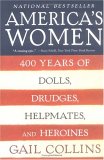Summary | Excerpt | Reading Guide | Reviews | Readalikes | Genres & Themes | Author Bio

Critics' Opinion:
Readers' Opinion:
First Published:
Sep 2003, 556 pages
Paperback:
Sep 2004, 592 pages
Almost everyone lived on a farm--the whole point of the colonial dream was to get your own land and grow a profitable cash crop like tobacco. The English believed that fieldwork was a man's task, but the colonies were desperately short on labor, and young planters expected their wives to labor alongside them in the fields. The farms were almost all isolated, surrounded by endless forests, down winding waterways without any real roads to connect them. Plantation owners were forced to be away from home for long periods of time on business, and they often depended on their wives, or even daughters, to drain swamps, tend cattle, cultivate the tobacco, and otherwise manage things while they were gone.
The dissolution of the normal boundaries between women's work and men's allowed some women to operate with an independence the nation would never really see again until the twentieth century. One of the most spectacular examples was Margaret Brent, who virtually ran the colony of Maryland during a period of crisis. Margaret, her sister Mary, and two brothers arrived in Maryland in 1638. The still-tiny colony was a haven for Catholics, the Brents' religion. It's possible that Margaret and Mary had embraced some form of lay sisterhood. They never married, which was practically unheard of in a land of woman-starved bachelors.
Virtually all the colonial women wanted to marry, but when they did, they were automatically stripped of their legal rights. A wife's possessions became her husband's, and she was unable to do business on her own, sue, borrow money, or sign contracts. ("The husband and wife are one, and the husband is that one," said Sir William Blackstone, the eminent English jurist.) But as unmarried women, the Brent sisters could own and manage their own property. Margaret had a letter from Lord Baltimore, the proprietor of the colony, granting them land in their own names. They established a home on a seventy-acre plot they named Sisters' Freehold in what is now southern Maryland, next to the estate of their brother Giles. The colony was still very young, with about 400 settlers, most of them tenant farmers or laborers who worked on the estates of a few wealthy landowners like the Brents.
Margaret became an active businesswoman, who specialized in lending money to newly arrived settlers. When her debtors failed to meet their obligations, she was quick to go to court to demand payment. Between 1642 and 1650, she was recorded as a party in 134 suits, mainly as plaintiff — representing herself in court and winning most of her cases. She became a close friend of Governor Leonard Calvert, the brother of Lord Baltimore, and the two became co-guardians of the young daughter of the chief of the Piscataway Indians. Margaret later permitted her brother Giles to marry the girl, who was only eleven years old, an act that made Giles's political opponents wary, and which certainly raises questions about whether Margaret was really looking after her ward's best interests.
Nothing Margaret wrote has survived, and we have no portraits of her. (Her contemporaries remembered her as a large woman with red hair.) Her great moment in American history came in 1645, when Maryland was drawn into the civil war being carried out in England between the forces of Charles I and the Puritan Parliament. Protestant mercenaries raided the lands of the Catholic settlers, and one of them sailed off to London with Giles Brent as a prisoner. It must have been a traumatic time for Margaret and Mary--their brother had been kidnapped and Governor Calvert eventually fled, leaving the remaining settlers at the mercy of the mercenaries. The colonists who stayed behind called it the "plundering time." The European population of Maryland dropped to under 100.
Governor Calvert finally returned in late 1646 at the head of a small band of soldiers and restored order. But he died in June 1647, while his restless army was still waiting to be paid for its services. There was a very real threat that if the money was not forthcoming, the soldiers would try to take it out of the hides of the colonists. On his deathbed, Calvert appointed Margaret Brent the executor of his estate, instructing her to "Take all and pay all." He had pledged his estate and that of his brother, Lord Baltimore, to satisfy the soldiers, but his own assets were far too insignificant to cover the costs. Margaret held the soldiers off, selling her own cattle to feed them and maneuvering to try to get money either from the colonial government or Lord Baltimore's estate. On January 21, 1648, she appeared before the Maryland Assembly and demanded two votes--one for herself and one as Lord Baltimore's representative. The Assembly declined to give her even one, and Margaret departed after lodging a protest against "all proceedings . . . unlesse shee may be present and have vote as aforesaid." Besides being regarded as the nation's first female lawyer, Margaret was the first colonial woman to demand the right to vote.
From America's Women by Gail Collins. Copyright © 2003 by Gail Collins. All rights reserved. No part of this book may be reproduced in any form without written permission from the publisher, HarperCollins Publishers.





The Funeral Cryer by Wenyan Lu
Debut novelist Wenyan Lu brings us this witty yet profound story about one woman's midlife reawakening in contemporary rural China.
Your guide toexceptional books
BookBrowse seeks out and recommends the best in contemporary fiction and nonfiction—books that not only engage and entertain but also deepen our understanding of ourselves and the world around us.